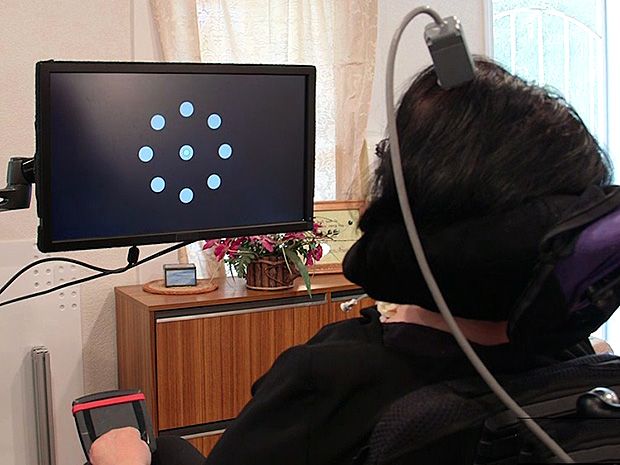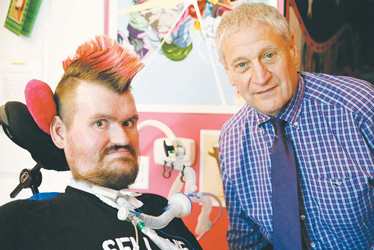Posted

Typing six words per minute may not sound very impressive. But for paralyzed people typing via a brain-computer interface (BCI), it’s a new world record.
To pull off this feat, two paralyzed people used prosthetics implanted in their brains to control computer cursors with unprecedented accuracy and speed. The experiment, reported today in Nature Medicine, was the latest from a team testing a neural system called BrainGate2. While this implant is only approved for experiments right now, researchers say this demonstration proves that such technology can be truly useful to quadriplegics, and points the way toward regular at-home use.
The two people who volunteered for this study have amyotrophic lateral sclerosis (ALS), also known as Lou Gehrig’s disease, a degenerative neural disorder that leads to complete paralysis. Lead researcher Jaimie Henderson, co-director of Stanford’s Neural Prosthetics Translational Lab, calls it a “humbling experience” to work with quadriplegic patients who willingly undergo brain surgery and devote themselves to science experiments that will push forward this early-stage technology. “They’ve become true partners with us in this endeavor,” Henderson says.
The BrainGate2 system consists of an array of minuscule electrodes implanted, in this case, in a region of the motor cortex known as the “hand knob.” The electrodes record the patterns of electrical activity in the neurons there, which fire when the person either moves or imagines moving their hand. The BrainGate2 system also includes decoding software, which turns a messy signal into a clear command for an external device—in this case, a computer cursor. Other experiments have used BCIs to control robotic arms, and they could theoretically be used to control wheelchairs, cars, or anything else that can be moved by remote control.
In this study’s first task, the participants repeatedly moved their cursors to targets on a computer screen (see video below), which they accomplished by imagining their index fingers moving on computer trackpads. They each averaged about 2.5 seconds per target. This is a significant improvement over a previous BrainGate2 trial, in which a different patient performed the same task but averaged 8.5 seconds per target.
The improvement, Henderson says, came from four factors.
1) The system architecture provided faster processing than before. With a lag time of only about 20 milliseconds between the user’s thought and the cursor’s action, the participants got useful feedback while doing the task.
2) Signal processing filters carefully extracted the neural signals from the ambient electromagnetic noise—a necessity, as these experiments were conducted in the volunteers’ homes.
3) The imagined motion that the participants ultimately used to control the cursor (an index finger moving on a trackpad) provided a clearer neural signal than other imagined motions they tried out (whole arm and wrist movements).
4) Perhaps most importantly, an improved decoding algorithm was better able to translate neural signals into intended movements. Essentially, it was better able to identify the direction the user intended to steer the cursor, and could therefore correct for deviations in the neural signal that would have otherwise steered the cursor off track.
But what about the typing, you ask? For that task, the participants used the same imagined finger movement to pick out letters in a text-entering program called Dasher. With this interface, once the user selects a letter, the program predicts which letters are likely to come next and makes them easier to select, speeding up the construction of words.
One of the participants typed 115 words in 19 minutes, or about 6 words per minute. That user had previous experience with the Dasher interface using a different control method, but it’s still a pretty impressive result. While this participant is still able to talk naturally, such a communication method could benefit people who have lost the ability to control their mouth muscles, such as people with more advanced ALS or “locked-in” patients.
Henderson and his colleagues have previously surveyed people with paralysis to see whether they’d be eager to adopt BCI technologies in their everyday lives, and what capabilities they’d hope to gain from such gear. High on the wish-list was the ability to communicate easily through fast typing, which the survey defined as 40 words per minute.
Henderson says he has plenty of ideas for how to reach that ambitious target. A future study might make use of electrodes implanted in a region of the brain that encodes a person’s intentions to move, before they actually make a motion. “We want to see if using those signals from the planning part of the brain helps improve performance,” he says.
It’s not clear what level of performance will be required before an implanted BCI device is considered ready for domestic use. But Henderson thinks the BrainGate2 system is well on the way: “We think we’re making very good progress,” he says.
To pull off this feat, two paralyzed people used prosthetics implanted in their brains to control computer cursors with unprecedented accuracy and speed. The experiment, reported today in Nature Medicine, was the latest from a team testing a neural system called BrainGate2. While this implant is only approved for experiments right now, researchers say this demonstration proves that such technology can be truly useful to quadriplegics, and points the way toward regular at-home use.
The two people who volunteered for this study have amyotrophic lateral sclerosis (ALS), also known as Lou Gehrig’s disease, a degenerative neural disorder that leads to complete paralysis. Lead researcher Jaimie Henderson, co-director of Stanford’s Neural Prosthetics Translational Lab, calls it a “humbling experience” to work with quadriplegic patients who willingly undergo brain surgery and devote themselves to science experiments that will push forward this early-stage technology. “They’ve become true partners with us in this endeavor,” Henderson says.
The BrainGate2 system consists of an array of minuscule electrodes implanted, in this case, in a region of the motor cortex known as the “hand knob.” The electrodes record the patterns of electrical activity in the neurons there, which fire when the person either moves or imagines moving their hand. The BrainGate2 system also includes decoding software, which turns a messy signal into a clear command for an external device—in this case, a computer cursor. Other experiments have used BCIs to control robotic arms, and they could theoretically be used to control wheelchairs, cars, or anything else that can be moved by remote control.
In this study’s first task, the participants repeatedly moved their cursors to targets on a computer screen (see video below), which they accomplished by imagining their index fingers moving on computer trackpads. They each averaged about 2.5 seconds per target. This is a significant improvement over a previous BrainGate2 trial, in which a different patient performed the same task but averaged 8.5 seconds per target.
The improvement, Henderson says, came from four factors.
1) The system architecture provided faster processing than before. With a lag time of only about 20 milliseconds between the user’s thought and the cursor’s action, the participants got useful feedback while doing the task.
2) Signal processing filters carefully extracted the neural signals from the ambient electromagnetic noise—a necessity, as these experiments were conducted in the volunteers’ homes.
3) The imagined motion that the participants ultimately used to control the cursor (an index finger moving on a trackpad) provided a clearer neural signal than other imagined motions they tried out (whole arm and wrist movements).
4) Perhaps most importantly, an improved decoding algorithm was better able to translate neural signals into intended movements. Essentially, it was better able to identify the direction the user intended to steer the cursor, and could therefore correct for deviations in the neural signal that would have otherwise steered the cursor off track.
But what about the typing, you ask? For that task, the participants used the same imagined finger movement to pick out letters in a text-entering program called Dasher. With this interface, once the user selects a letter, the program predicts which letters are likely to come next and makes them easier to select, speeding up the construction of words.
One of the participants typed 115 words in 19 minutes, or about 6 words per minute. That user had previous experience with the Dasher interface using a different control method, but it’s still a pretty impressive result. While this participant is still able to talk naturally, such a communication method could benefit people who have lost the ability to control their mouth muscles, such as people with more advanced ALS or “locked-in” patients.
Henderson and his colleagues have previously surveyed people with paralysis to see whether they’d be eager to adopt BCI technologies in their everyday lives, and what capabilities they’d hope to gain from such gear. High on the wish-list was the ability to communicate easily through fast typing, which the survey defined as 40 words per minute.
Henderson says he has plenty of ideas for how to reach that ambitious target. A future study might make use of electrodes implanted in a region of the brain that encodes a person’s intentions to move, before they actually make a motion. “We want to see if using those signals from the planning part of the brain helps improve performance,” he says.
It’s not clear what level of performance will be required before an implanted BCI device is considered ready for domestic use. But Henderson thinks the BrainGate2 system is well on the way: “We think we’re making very good progress,” he says.

